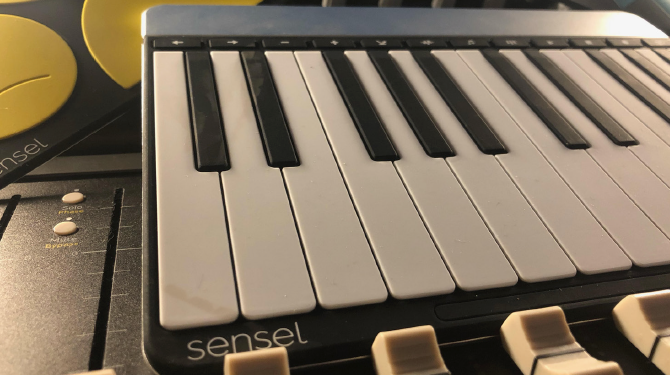It’s the size of an iPad, it’s an incredibly responsive Bluetooth MIDI controller, and it’s got MIDI Polyphonic Expression (MPE) multi-touch technology. These are just three of many reasons that the Sensel Morph is well worth a look.
The Sensel Morph is very well built, and looks fantastically sleek. Imagine a cross between an iPad and a giant Apple Trackpad, except this surface is super-smart. It features approximately 20,000 sensors which allow it to detect an incredible range of pressure (from 1g to 5kg) – and it is remarkably accurate, which is evident when you bring up the Visualiser in the Sensel App.
Sensel Morph is priced very attractively at £185 and is probably the easiest way of getting into using MPE technology. It’s an incredibly simple and intuitive device, super portable, and works with beautifully designed magnetic overlays which become your work surfaces: from a simple Piano (which I am using for this review) to Music Production, Drum Pad, and Buchla Thunder – and this is just for audio, there are loads more Sensel overlays designed for developers, video editors, designers, and artists. So it’s very much a multi-application device.
But today I am using the Piano overlay, which feels quite piano-like to me right away despite the fact it’s almost pocket sized; probably due to the slightly raised black keys which gives you the feel of a keyboard. There are also a series of macros which allow for sustain, changing of octave, full chord mode, and so on. And if you want to change your overlay, you don’t even need to switch the unit off – just pull one off and slap on another. The Sensel App sends ‘maps’ of said overlays to the unit in seconds once you’re connected via USB and you’re good to go. It couldn’t be simpler, in fact.
The Morph works on Bluetooth too, which is a dream in a small space – especially in my studio, as I have four keyboards in here, and you couldn’t swing a cat! The Morph sits on my lap or desk without taking up any real space, and once you get used to the sensitivity, you realise it’s an incredibly playable and creative tool. The battery life is also fantastic – it didn’t get close to losing power despite the many operation hours.
MPE is pretty new to me as a producer and musician. I am aware of it, but before the Sensel Morph arrived at my studio, I was yet to experiment with it in a creative fashion. Such was the excitement of using MPE, I’d bought Auras by Slate + Ash – the first Kontakt library designed to work with MPE. And boy, was I in for a treat.
So what is MPE? For those who aren’t aware, it essentially allows you to take the articulation of an acoustic instrument with an infinite palette of electronic sounds, enabling you to morph them (hence the name) into something totally unique. There are a few keyboards and controllers on the market designed for MPE workflow, and a number of hardware synths can receive MPE signal – though the VST software instruments that are MPE compatible are perhaps the most exciting to work with.




